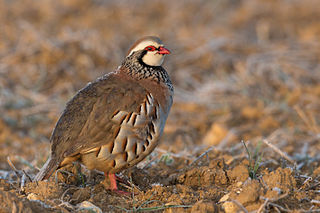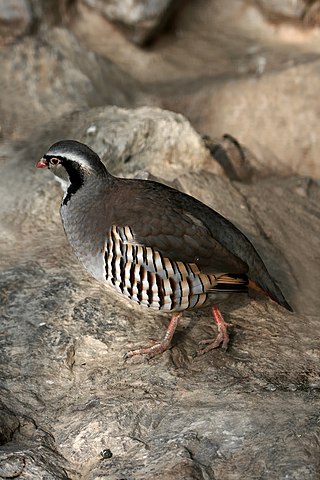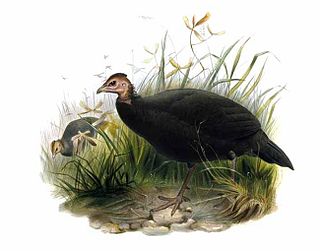
A partridge is a medium-sized galliform bird in any of several genera, with a wide native distribution throughout parts of Europe, Asia and Africa. Several species have been introduced to the Americas. They are sometimes grouped in the Perdicinae subfamily of the Phasianidae. However, molecular research suggests that partridges are not a distinct taxon within the family Phasianidae, but that some species are closer to the pheasants, while others are closer to the junglefowl.

Harry St John Bridger Philby, CIE, also known as Jack Philby or Sheikh Abdullah, was a British Arabist, adviser, explorer, writer, and a colonial intelligence officer who served as an advisor to King Abdulaziz ibn Saud, the founder of Saudi Arabia.

The red-legged partridge is a gamebird in the pheasant family Phasianidae of the order Galliformes, gallinaceous birds. It is sometimes known as French partridge, to distinguish it from the English or grey partridge. The genus name is from Ancient Greek alektoris a farmyard chicken, and rufa is Latin for red or rufous.

The black francolin is a gamebird in the pheasant family Phasianidae of the order Galliformes. It was formerly known as the black partridge. It is the state bird of Haryana state, India. Fried black francolin is eaten in Azerbaijani cuisine.

The chukar partridge, or simply chukar, is a Palearctic upland gamebird in the pheasant family Phasianidae. It has been considered to form a superspecies complex along with the rock partridge, Philby's partridge and Przevalski's partridge and treated in the past as conspecific particularly with the first. This partridge has well-marked black and white bars on the flanks and a black band running from the forehead across the eye down the head to form a necklace that encloses a white throat. Native to Asia, the species has been introduced into many other places and feral populations have established themselves in parts of North America and New Zealand. This bird can be found in parts of Middle East and temperate Asia.

The rock partridge or common rock partridge is a gamebird in the pheasant family, Phasianidae, of the order Galliformes. It is native to southern Europe, and is closely related and very similar to its eastern equivalent, the chukar partridge, A. chukar.

The pin-tailed sandgrouse is a medium large bird in the sandgrouse family. It has a small, pigeon-like head and neck and a sturdy, compact body. It has long pointed wings, which are white underneath, a long tail and a fast direct flight. Flocks fly to watering holes at dawn. The call is a loud kattar-kattar. This gregarious species breeds on dry open treeless plains and similar habitats. Its nest is a ground scrape into which two or three cream-coloured eggs with cryptic markings are laid. Both sexes incubate the eggs.

The sand partridge is a gamebird in the pheasant family Phasianidae of the order Galliformes, gallinaceous birds.

Alectoris is a genus of partridges in the family Phasianidae, closely related to Old World quail, snowcocks (Tetraogallus), partridge-francolins (Pternistis), bush quail (Perdicula), and sand and see-see partridges (Ammoperdix). Members of the genus are known collectively as rock partridges. The genus name is derived from the Ancient Greek: αλέκτωρ, romanized: alektoris, meaning "chicken" or "farmyard fowl".

The yellow-legged buttonquail is a buttonquail, one of a small family of birds which resemble, but are unrelated to, the true quails. This family is peculiar in that the females are larger and more colourful than the males and are polyandrous.

Salvadori's pheasant is a landfowl bird of genus Lophura, native to Indonesia. It is found in the mountain rainforests of Sumatra. Thus it is also known as the Sumatran pheasant. The Hoogerwerf's pheasant is usually thought to be a subspecies. This bird was first described in 1879 by the Italian ornithologist Tommaso Salvadori. The species name inornata means "without ornament".

The black guineafowl is a member of the guineafowl bird family. It occurs in humid forests in Central Africa. It is a medium-sized black bird with a bare, pink head and upper neck. Little is known of its behaviour.

The Arabian partridge is a species of bird in the family Phasianidae, native to the southern Arabian peninsula. Two subspecies are recognised, A. m. melanocephala and A. m. guichardi. It sometimes hybridises with Philby's partridge and with the rock partridge.

The rufous-throated partridge is a species of bird in the family Phasianidae. It is found in montane forests in India and Southeast Asia. The International Union for Conservation of Nature (IUCN) has assessed it as a least-concern species.

The crestless firebacks are a group of two species of bird in the family Phasianidae. They are found in Brunei, Indonesia, Malaysia, and Singapore. Their natural habitat is subtropical or tropical moist lowland forests. They are threatened by habitat destruction.

The spotted sandgrouse is a species of ground dwelling bird in the family Pteroclidae. It is found in arid regions of northern and eastern Africa and across the Middle East and parts of Asia as far east as northwest India. It is a gregarious, diurnal bird and small flocks forage for seed and other vegetable matter on the ground, flying once a day to a waterhole for water. In the breeding season pairs nest apart from one another, the eggs being laid in a depression on the stony ground. The chicks leave the nest soon after hatching and eat dry seed, the water they need being provided by the male which saturates its belly feathers with water at the waterhole. The spotted sandgrouse is listed as being of "least concern" by the International Union for Conservation of Nature in its Red List of Threatened Species.

The red-backed buttonquail is a species of bird in the family Turnicidae. It is found in Australia, Indonesia, Papua New Guinea, the Philippines and the Solomon Islands. Other names by which it is known in different parts of its range include black-backed, black-spotted and orange-breasted buttonquail. There are fourteen recognised subspecies.

Perdicinae is a polyphyletic former subfamily of birds in the pheasant family, Phasianidae, regrouping the partridges, Old World quails, and francolins. Although this subfamily was considered monophyletic and separated from the pheasants, tragopans, junglefowls, and peafowls (Phasianinae) till the early 1990s, molecular phylogenies have shown that these two subfamilies actually constitute only one lineage. For example, some partridges are more closely affiliated to pheasants, whereas Old World quails and partridges from the Alectoris genus are closer to junglefowls. Due to this, the subfamily Perdicinae is no longer recognized by the International Ornithological Congress, with the species being split among 3 subfamilies.


















